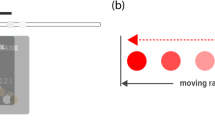Abstract
Raised-line drawings of common objects can be identified by congenitally and early blind subjects1,2 and displays of this type are being devised for use in education (for example, ref. 3). Although a teacher may think it helpful to guide a blind student's hand around one of these drawings, several theories of perception predict that the guidance would be detrimental as passive perception is generally considered to be inferior to active perception (for review see ref. 4). We show here, however, that guidance is helpful and leads to better identification than unguided exploration. We also report that the information used to identify raised-line drawings is predominantly kinaesthetic.
This is a preview of subscription content, access via your institution
Access options
Subscribe to this journal
Receive 51 print issues and online access
$199.00 per year
only $3.90 per issue
Buy this article
- Purchase on Springer Link
- Instant access to full article PDF
Prices may be subject to local taxes which are calculated during checkout
Similar content being viewed by others
References
Kennedy, J. M. & Fox, N. in The Arts and Cognition (eds Perkins, D. & Leondar, B.) (John Hopkins University Press, Baltimore, 1977).
Kennedy, J. M., Fox, N. & O'Grady, K. Harv. Education Ass. Bull. 16, 22 (1972).
Gordon, G. (ed.) Active Touch (Pergamon, New York, 1978).
Kennedy, J. M. in Handbook of Perception VIII (eds Carterette, E. C. & Friedman, M. P.) (Academic, New York, 1975).
Author information
Authors and Affiliations
Rights and permissions
About this article
Cite this article
Magee, L., Kennedy, J. Exploring pictures tactually. Nature 283, 287–288 (1980). https://doi.org/10.1038/283287a0
Received:
Accepted:
Issue Date:
DOI: https://doi.org/10.1038/283287a0
This article is cited by
-
Stories, journeys and smart maps: an approach to universal access
Universal Access in the Information Society (2022)
-
Poor resolution at the back of the tongue is the bottleneck for spatial pattern recognition
Scientific Reports (2020)
-
Visual inputs and postural manipulations affect the location of somatosensory percepts elicited by electrical stimulation
Scientific Reports (2019)
-
Defining filled and empty space: reassessing the filled space illusion for active touch and vision
Experimental Brain Research (2016)
-
Exploratory Procedures Employed by Visually Impaired Children During Joint Book Reading
Journal of Developmental and Physical Disabilities (2014)
Comments
By submitting a comment you agree to abide by our Terms and Community Guidelines. If you find something abusive or that does not comply with our terms or guidelines please flag it as inappropriate.



